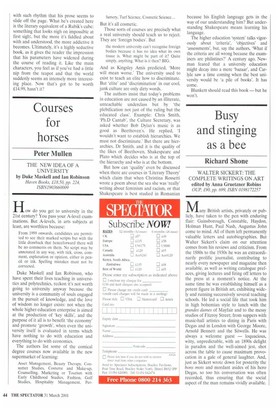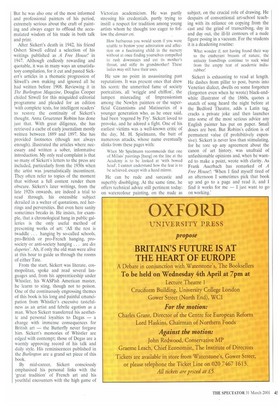Busy and stinging as a bee
Richard Shone
WALTER SICKERT: THE COMPLETE WRITINGS ON ART edited by Anna Gruetzner Robins OUP, £90, pp. 699, ISBN 0198172257 Many British artists, privately or publ'cly, have taken to the pen with enduring flair: Gainsborough, Constable, Haydon, Holman Hunt, Paul Nash, Augustus John come to mind. All of them left permanently valuable letters and autobiographies. But Walter Sickert's claim on our attention comes from his reviews and criticism. From the 1880s to the 1930s he was an extraordinarily prolific journalist, contributing to nearly every newspaper and magazine then available, as well as writing catalogue prefaces, giving lectures and firing off letters to the press at a moment's notice. At the same time he was establishing himself as a potent figure in British art, exhibiting widely and running successively several teaching schools. He led a social life that took him in high bohemian style to lunch with the grandes dames of Mayfair and to the messy studios of Fitzroy Street; from suppers with music-hall artistes to dining in Paris with Degas and in London with George Moore, Arnold Bennett and the Sitwells. He was always a welcome guest — loquacious, witty, unpredictable, with an 1890s delight in paradox and the well-aimed jest, shot across the table to cause maximum provocation in a gale of general laughter. And, just as Sickert wrote down for posterity the bons mots and mordant asides of his hero Degas, so too his conversation was often recorded, thus ensuring that the social aspect of the man remains vividly available.
But he was also one of the most informed and professional painters of his period, extremely serious about the craft of painting and always eager to offload the accumulated wisdom of his trade in both talk and print.
After Sickert's death in 1942, his friend Osbert Sitwell edited a selection of his writings published as A Free House! in 1947. Although endlessly rewarding and quotable, it was in many ways an unsatisfa tory compilation, for it cut and pasted Sick ert's articles in a thematic progression of Sitwell's own making and ignored all he had written before 1908. Reviewing it in The Burlington Magazine, Douglas Cooper chided Sitwell for this misguided editorial programme and pleaded for an edition 'with complete texts, for intelligent readers' to restore the continuity of Sickert's thought, Anna Gruetzner Robins has done just that, With great diligence, she has retrieved a cache of early journalism mostly written between 1889 and 1897. She has provided footnotes (though not always enough), illustrated the articles where nec essary and written a sober, informative introduction. My only real complaint is that so many of Sickert's letters to the press are included, particularly from the 1930s when the artist was journalistically incontinent. They often refer to topics of the moment that without a full context render them obscure. Sickert's later writings, from the late 1920s onwards, are indeed a trial to read through, his ostensible subject derailed in a welter of quotations, red herrings and perversities. But even here sanity sometimes breaks in. He insists, for exam ple, that a chronological hang in public galleries is the only useful method of presenting works of art: 'All the rest is twaddle . . hanging by so-called schools, pro-British or pro-French hanging, pro society or anti-society hanging ... are des duperies' An, if only the old man were alive at this hour to guide us through the rooms of either Tate.
From the start, Sicken was literate, cosmopolitan, spoke and read several lan guages and, from his apprenticeship under Whistler, his WASPish American master, he learnt to sting, though not to poison.
One of the continuously engrossing themes of this book is his long and painful emancipation from Whistler's excessive tasteful ness as an artist and febrile egotism as a man. When Sickert transferred his aesthetic and personal loyalties to Degas — change with immense consequences for British art — the Butterfly never forgave him. Sickert's memories of Whistler are edged with contempt; those of Degas are a warmly approving record of his talk and daily style. His reminiscences published in the Burlington are a grand set piece of this book.
By mid-career, Sicken consciously emphasised his personal links with the 'great tradition' of French art and his youthful encounters with the high game of Victorian academicism. He was partly stressing his credentials, partly trying to instill a respect for tradition among young artists whom he thought too eager to follow the dernier cri.
How barbarous you would seem if you were unable to bestow your admiration and affection on a fascinating child in the nursery without at once finding yourselves compelled to rush downstairs and cut its mother's throat, and stifle its grandmother! These ladies may still have their uses.
He saw no point in assassinating past reputations. It was present ones that drew his scorn: the unmerited fame of society portraitists, all 'wriggle and chiffon', the lumpen misreading of Impressionism among the Newlyn painters or the superficial Cezannisms and Matisseries of a younger generation who, as he once said, had been `rogered by Fry'. Sickert loved to provoke, and he adored a fight. One of his earliest victims was a well-known critic of the day, M. H. Spielmann, the butt of numerous attacks, whose name eventually slinks from these pages with: When Mr Spielmann recommends that one of Millais' paintings [hung] on the line at the Academy is to be looked at 'with bowed bead', I cannot understand how the feat is to be achieved, except with a hand mirror.
He can be rude and sarcastic and superbly disobliging. At the same time, he offers technical advice still pertinent today: on watercolour painting, on the nude as
subject, on the crucial role of drawing. He despairs of conventional art-school teaching with its reliance on copying from the cast and the grind of transcribing, day in and day out, the contours of a nude figure posing in a vacuum. For the students it is a deadening routine:
What wonder if, not having found their way to the • exuberant breasts of nature, the unlucky foundlings continue to suck wind from the empty teat of academic indiarubber!
Sickert is exhausting to read at length. He dashes from pillar to post, bursts into Venetian dialect, dwells on some forgotten (forgotten even when he wrote) black-andwhite illustrator of the 1860s, quotes a snatch of song heard the night before at the Bedford Theatre, adds a Latin tag, cracks a private joke and then launches into some of the most serious advice any English painter has put on paper. Small doses are best. But Robins's edition is of permanent value (if prohibitively expensive). Sickert is never less than stimulating, for he tore up any agreement about the canon of art history, was unafraid of unfashionable opinions and, when he wanted to make a point, wrote with clarity. As Frank Auerbach has remarked of A Free House!: 'When I find myself tired of an afternoon I sometimes pick that book up and go to a page and read it, and I find it works for me — I just want to go on working.



























































































 Previous page
Previous page